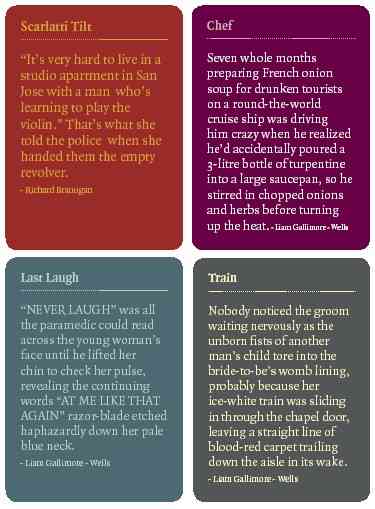
T his concept, of one-minute piano compositions, arose as] a component of the first-year piano test in which all students are required to learn a short piece without assistance in seven days [at University of Surrey School of Music]. Though the students find this demanding, it is actually a very good test of their musicianship. The ‘Spectrum’ series deserves mention too: compiled by Thalia Myers and published by the Associated Board, it is a collection of short piano pieces by distinguished composers presented for students at a variety of levels of ability. I was also aware of the component of the composition course to write a piece of one minute for one instrument: it is a challenge for a composer to be able to communicate a sense of personal style within this time-frame. For me as a performer with a great deal of experience of working in new music as well as with student composers in workshops, there was clearly something personal which I felt able to contribute.”Their small size belies the big challenges that ‘miniatures’ present, both to the composer and to the performer. ... And, come to think of it, to the listener.
— Clive Williamson, Professor of Keyboard, School of Music, University of Surrey.
Subsequent to the University of Surrey program referred to in the blockquote above, Clive Williamson recorded 36 of these on a disk released on Cadenza Records two years ago. His performance of each one is meticulous and empathetic, brilliant.

Clive has been a soloist at the Barbican, Queen Elizabeth Hall, Wigmore Hall, and many other venues throughout Europe and America. He has performed on BBC2 (‘Music in Camera’) and Channel 4 (‘Scipio’s Dream’). Additionally, he has been a guest artist with the London Sinfonietta, the Composers’ Ensemble, Sinfonia 21, and Sound Intermedia. He records for BBC Radio 3, West German Radio, and Netherlands Radio, and on the Col Legno, Wergo, Hyperion, and Cadenza labels. He trained at York University and the Royal Academy of Music with Ruth Harte, among others.
The technical and emotional palettes represented in the ‘One-Minute Wonders’ collection are tremendously diverse. Some of the pieces are ‘novelties’—humorous responses to the one-minute compositional challenge, performed in a jesting manner. But other of the pieces are serious, just as some so-called ‘microfiction’ (ultra-short stories, generally less than 250 words long; 2 min) or ‘nanofiction’ (complete stories in 55 words; 30 sec) is serious. [cf. ‘flash fiction’ (500 to 1,500 words; 4 to 10 min) and ‘sudden fiction’ (1,500 to 4,500 words; 10 to 30 min).]

For the composer just as for the microfiction author, it’s a huge challenge to say something worthwhile in so small a space. The ‘density’ of expression entails big risks, of turning out contrived or forced or trite. Assuming that the composer succeeds in creating something that’s emotionally genuine and aesthetically interesting, for the performer it’s then a monumental challenge to enter into the piece and effectively deliver authenticity in so short a time. For the audience members, it’s a huge challenge to quickly apprehend what’s being set before them.
The beginning sentence is difficult. Who are you? Somebody! Do you want your piece to open with notes evoking a character doing something or thinking about something? You haven’t the luxury of putting a theme forward and letting it register with the listener/performer for a goodly number of measures; you have to figure out crystal-clear cues, ones that orient the listener/performer quickly.
What’s more, you have to have some sense for the neurophysiology of context-switching and memory, how fast the listener/performer can adapt to new ideas you introduce, or to transitions between ideas. You have to consider the diversity of your listeners/performers, in terms of their attentiveness and receptiveness to the ideas you are laying down. When people become charcters, they’re no longer fully ‘human’; they're symbols to be ‘pointed out’. Indicial/referential icons, nothing more.
 Begin your one-minute wonder:
Begin your one-minute wonder:- With a generalization or pastiche of something that's familiar (like Michael Finnissy does with his send-up of Chopin’s Op. 64 No. 1);
- With a narrative summary that sketches and encapsulates the whole piece;
- With a syntactical curiosity, a palindrome, or a chiasmus that begs the question as to whether we fully understand things that are conventional wisdom or second-nature—or that intrigues the listener by way of inviting consideration of a seeming absurdity;
- With a dramatic morsel of dialogue;
- With several characters already in-action but no dialogue;
- With a vivid setting and a solitary character;
- With a performer/narrator reminiscing or establishing a point of view in first person;
- With the performer/narrator describing something in third person.
B revity and Conciseness are the parents of Correction.”The coincidence of the registral and (experienced) dynamic shapes of the music in the first few bars almost have to generate a strong cadential feeling, or the piece will fall apart before our eyes (ears). But how far should we go in terms of ‘tessitura’?
— Hosea Ballou.
And how about the dynamics? What to do to insure that we capture the aural attention of the listeners, and yet not devolve into clichés and cheap theatrics?
The resolution/ending is just as challenging as all the rest. Actually, G. Thomas has some wonderful suggestions that are as useful for composers as they are for authors.
Here are some example 30-sec MP3 clips from his ‘One-Minute Wonders’ CD. The accompanying books containing sheetmusic for these compositions are inexpensive (£10) and nicely laid-out and printed. You may find miniatures like the ones represented on Williamson’s disk are useful in your repertoire. Some, like the Benjamin Hooper one, have virtuosic qualities that are well-disposed to serving as encore material. Other ones are coloristic and bonbon-like but are more contemplative or enigmatic than is usually suitable for an encore.
Composers may likewise find these instructive, emblematic as they are of a variety of gestures and tropes and architectures in miniature.

No comments:
Post a Comment